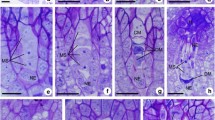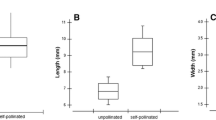Abstract
Gametophytic organization, fertilization and reproductive success are described for the fertile diploid Brachiaria brizantha accession BRA-002747 which is being raised for use in Brachiaria breeding programs, as well as to understand and control of apomixis in this genus. The current paper reports on reproductive biology and analysis of seed set in field experiments during three consecutive years. Unsuccessful seed production in this plant is believed to correlate with early inbreeding depression, based on the reproductive features analyzed. Caryopsis development was observed using differential interference contrast microscopy with seed set determined by the number of self- and open-pollinated pistils that fully developed into viable seeds. Developing and mature female and male gametophytes were observed in the context of flower phenology, morphology and anthesis patterns. Pollen viability was determined by acetocarmine staining and by observation of germination in vivo, which was also used to observe pollen tube/pistil interaction. Although normal development was observed in floral structures, anthesis and gametophytes, seed set was low, with 2 and 6% in self- and open-pollination, respectively, producing seed. Variations observed in the female organs, such as the presence of a hermaphrodite flower in 50% of the inferior floscules and the presence of multiple embryo sacs of the Polygonum type within the same ovule in 15% of the pistils, are not related to low fertility. The majority of pollen grains are viable, in spite of the reduced number of pollen tubes within the style and ovary carpel, and a developing caryopsis was observed in 70% of self-pollinated pistils, indicating successful double fertilization from 2 days after anthesis (DAA). Nevertheless, abortion gradually increased from 2 until 7 DAA and remains elevated until 12 DAA, when caryopsis maturity is achieved. These data confirm low seed set in this accession and indicate that low fertility is not a consequence of abnormalities, either in the floral or gamete structures, or pollen tube rejection, but most likely a consequence of inbreeding depression.







Similar content being viewed by others
References
Alves ER (2000) Aspectos da Reprodução em Brachiaria brizantha cv. Marandu. Master Thesis, Universidade de Brasília, Brasília, Brazil
Alves ER, Carneiro VTC, Araujo ACG (2001) Direct evidence of pseudogamy in an apomictic Brachiaria brizantha (Poaceae). Sex Plant Reprod 14:207–212
Alves E, Carneiro VTC, Dusi DMA (2007) In situ localization of three cDNA sequences associated to the later stages of aposporic embryo sac development of Brachiaria brizantha. Protoplasma (in press)
Araujo ACG, Falcão R (2003a) Característica floral atípica em Brachiaria brizantha (Poaceae). Com Técnico 82. Brasília, Brazil: Embrapa: Recursos Genéticos e Biotecnologia, 5 pp
Araujo ACG, Falcão R (2003b) Observação de múltiplos sacos embrionários em ovário de plantas do acesso sexual de Brachiaria brizantha (Poaceae). Bol Pesq Desenv 40. Brasília, Brazil: Embrapa: Recursos Genéticos e Biotecnologia, 16 pp
Araujo ACG, Falcão R (2004) Identificação de acessos de Brachiaria com interesse ao estudo da apomixia facultativa. Bol Pesq Desenv, 74. Brasília, Brazil: Embrapa: Recursos Genéticos e Biotecnologia, 29 pp
Araujo ACG, Mukhambetzhanov S, Pozzobon MT, Santana EF, Carneiro VTC (2000) Female gametophyte development in apomictic and sexual Brachiaria brizantha (Poaceae). Rev Cytol Biol Veg Le Botaniste XXIII:13–28
Araujo ACG, Nóbrega JM, Pozzobon MT, Carneiro VTC (2005a) Evidence of sexuality in induced tetraploids of Brachiaria brizantha (Poaceae). Euphytica 144:39–50
Araujo ACG, Falcão R, Carneiro VTC (2005b) Towards the origin of the multiple embryo sacs in the diploid, sexual accession of Brachiaria brizantha (Poaceae). Braz J Morphol Sci Supp 264–265
Araujo ACG, Falcão R, Carneiro VTC (2005c) Altered female gametogenesis in the diploid sexual accession of Brachiaria brizantha (Poaceae). Documentos, 139. Brasília, Brazil Embrapa Recursos Genéticos e Biotecnologia, Brazil
Asker SE, Jerling L (1992) Apomixis in Plants. CRC Press, Boca Raton
Baumann U, Juttner J, Bian X, Langride P (2000) Self-incompatibility in the grasses. Ann Bot 85(Supp A):203–209
Bush EJ, Barret SCH (1993) Genetics of mine invasions by Deschampsia cespitosa (Poaceae). Can J Bot 71:1336–1348
Carnahan HL, Hill HD (1958) Apomixis in the Gramineae: Panicoideae. Am J Bot 54:253–253
Charlesworth D, Charlesworth B (1987) Inbreeding depression and its evolutionary consequences. Ann Rev Ecol Syst 18:237–268
Clayton WD, Renvoize SA (1986) Genera Graminum Grasses of the world. Additional Scenes, XIII Her Majesty’s Stationery Office, Royal Botanic Gardens, Kew. London Kew Bulletin
De Nettancourt D (1997) Incompatibility in angiosperms. Sex Plant Reprod 10:185–199
Dusi DMA, Willemse MTM (1999) Apomixis in Brachiaria decumbens Stapf: gametophytic development and reproductive calendar. Acta Biol Cracov Soc Bot 41:151–162
East EM (1940) The distribution of self-sterility in flowering plants. Proc Am Philos Soc 82:449–518
Fukui K, Nakayama S (1996) Plant chromosomes: laboratory methods. CRC Press, London
Gibbs P, Bianchi MB, Taroda Ranga N (2004) Effects of self-, chase and mixed self/cross-pollinations on pistil longevity and fruit set in Ceiba species (Bombacaceae) with late-acting self-incompatibility. Ann Bot 94:305–310
Gobbe J, Longly B, Louant BP (1982a) Calendrier des sporogénèse et gametogénèse femelles chez le diploïde et le tétraploïde induit de Brachiaria ruziziensis (Graminée). Can J Bot 60:2032–2036
Gobbe J, Swenne A, Louant BP (1982b) Diploïdes naturels et autotetraploïdes induits chez Brachiaria ruziziensis Germain et Evrard: critères d’ identification. Agro Tropic 36:339–346
Gustafsson A (1946–1947) Apomixis in higher plants. Parts I, II, II. Lunds Universitets Arssk. N.F. pp 42–43:1–370
Husband BC, Schenske DW (1996) Evolution of the magnitude and timing of inbreeding depression in plants. Evolution 50:54–70
Keller-Grein G, Maass BL, Hanson J (1996) Natural variation in Brachiaria and existing germplasm collections. In: Miles JW, Maass BL, Valle CB do (eds) Brachiaria: biology, agronomy, and improvement. CIAT, Colombia, pp 16–42
Lundqvist A (1964) The nature of the two-loci incompatibility system in grasses. IV. Interaction between the loci relation to pseudocompatibility in Festuca pratensis Huds. Hereditas 52:221–234
Lutts S, Ndikumana J, Louant BP (1991) Fertility of Brachiaria ruziziensis in interspecific crosses with Brachiaria decumbens and Brachiaria brizantha: meiotic behavior, pollen viability and seed set. Euphytica 57:267–274
Lutts S, Ndikumana J, Louant BP (1994) Male and female sporogenesis and gametogenesis in apomictic Brachiaria brizantha, Brachiaria decumbens and F1 hybrids with sexual colchicine induced tetraploid Brachiaria ruziziensis. Euphytica 78:19–25
Martin FM (1959) Staining and observing pollen tubes in the style by means of fluorescence. Stain Technol 34:436–437
Matton DP, Nass N, Clarke AE, Newbigin E (1994) Self-incompatibility: how plants avoid illegitimate offspring. Proc Natl Acad Sci USA 91:1992–1997
Mendes-Bonato AB, Pagliarini MS, Forli F, Valle CB do, Penteado MIO (2002) Chromosome numbers and microsporogenesis in Brachiaria brizantha. Euphytica 125:419–425
Ndikumana J (1985) Étude de l’hibridation entre espèces apomictiques et sexuées dans le genre Brachiaria. PhD Thesis, Université de Louvain, Louvain-la-Neuve, Belgium
Ngendahayo M, Coppens d’Eeckenbrugge, Loaunt BP (1988) Self-incompatibility studies in Brachiaria ruziziensis Germain et Evrard, Brachiaria decumbens Stapf and Brachiaria brizantha (Hoschst) Stapf and their interspecific hybrids. Phytomorphology 38:47–51
Nunes SG (1984) Brachiaria brizantha cv. Marandu Documentos 21. Embrapa-CNPGC, Campo Grande, MS, Brazil
Penteado MI de O, Santos ACM dos, Rodrigues JF, Valle CB do, Seixas MAC, Esteves A (2000) Determinação de ploidia e quantidade de DNA em diferentes espécies do gênero Brachiaria. Bol Pesq 11. Embrapa-CNPGC, Campo Grande, MS, Brazil, pp 31
Pinheiro AA, Pozzobon MT, Valle CB do, Penteado MIO, Carneiro VTC (2000) Duplication of the chromosome number of diploid Brachiaria brizantha plants, using colchicine. Plant Cell Rep 19:274–278
Quarin CL, Hanna WW (1980) Effect of three ploidy levels on meiosis and mode of reproduction in Paspalum hexastachyum. Crop Sci 20:69–75
Renvoize SA, Clayton WD, Kabuye CHS (1996) Morphology, taxonomy and natural distribution of Brachiaria (Trin.) Griseb. In: Miles JW, Maass BL, Valle CB do (eds) Brachiaria: biology, agronomy, and improvement. CIAT, Colombia, pp 1–15
Rodrigues-Otubo BM, Penteado MI de O, Valle CB do (2000) Embryo rescue of interspecific hybrids of Brachiaria spp. Plant Cell Tissue Organ Cult 61:175–182
Rodrigues JCM, Cabral GB, Dusi DMA, Mello LV, Rigden D, Carneiro VTC (2003) Identification of differentially expressed cDNA sequences in ovaries of sexual and apomictic plants of Brachiaria brizantha. Plant Mol Biol 53:745–757
Sage TL, Sampson FB (2003) Evidence for ovarian self-incompatibility as a cause of self-sterility in the relictual woody angiosperm Pseudowintera axillaris (Winteraceae). Ann Bot 91:807–816
Sage TL, Strumas F, Cole WW, Barrett SCH (1999) Differential ovule development following self- and cross-pollination: the basis of self-sterility in Narcissus triandrus (Amaryllidaceae). Am J Bot 86:855–870
Savidan Y (2001) Transfer of apomixis through wide crosses. In: Savidan Y, Carman JG, Dresselhaus T (eds) The flowering of apomixis: from mechanisms to genetic engineering. CIMMYT, IRD, European Commission DG VI (FAIR), Mexico, DF, pp 153–166
Seavey SR, Bawa KS (1986) Late acting self-incompatibility in angiosperms. Bot Rev 52:195–219
Seavey SR, Carter SK (1996) Ovule fates in Epilobium obcordatum (Onagraceae). Am J Bot 83:316–325
Shafer GS, Burson BL, Hussey MA (2000) Stigma receptivity and seed set in protogynous buffelgrass. Crop Sci 40:391–397
Stebbins GL (1950) Variation and evolution in plants. Columbia University Press, New York
Swenne A, Louant BP, Dujardin M (1981) Induction par la colchicine de formes autotetraploïdes chez Brachiaria ruziziensis Germain et Evrard (Graminée). Agron Trop 36:134–141
Valle CB do (1986) Cytology, mode of reproduction and forage quality of selected species of Brachiaria Griseb. PhD Thesis, University of Wisconsin, Madison, USA
Valle CB do (1990) Coleção de germoplasma de espécies de Brachiaria no CIAT: estudos básicos visando ao melhoramento genético. Documentos Embrapa—CNPGC, Campo Grande, MS, Brazil
Valle CB do, Glienke C (1991) New sexual accessions in Brachiaria. Apo Newsl 3:11–13
Valle CB do, Savidan Y (1996) Genetics, cytogenetics, and reproductive biology of Brachiaria. In: Miles JW, Maass BL, Valle CB do (eds) Brachiaria: biology, agronomy, and improvement. CIAT, Colombia, pp 147–163
Young BA, Sherwood RT, Bashaw EC (1979) Cleared-pistil and thick-sectioning techniques for detecting aposporous apomixis in grasses. Can J Bot 57:1668–1672
Author information
Authors and Affiliations
Corresponding author
Additional information
Communicated by Scott Russell.
Rights and permissions
About this article
Cite this article
Araujo, A.C.G., Falcão, R. & Carneiro, V. Seed abortion in the sexual counterpart of Brachiaria brizantha apomicts (Poaceae). Sex Plant Reprod 20, 109–121 (2007). https://doi.org/10.1007/s00497-007-0048-6
Received:
Accepted:
Published:
Issue Date:
DOI: https://doi.org/10.1007/s00497-007-0048-6




